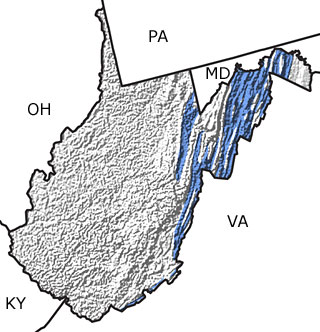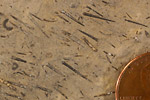Paleontology and geologyDuring the Early Devonian, a shallow sea covered West Virginia. The sea deepened during the Middle Devonian and water circulation became restricted, thus few organisms lived on the sea floor. The lack of oxygen also meant that what organic material was present did not decay thoroughly, resulting in the formation of organic-rich black shales. A Late Devonian mountain building event (the Acadian Orogeny) produced a large delta, the Catskill Delta, as thousands of feet of clastic sediments were eroded off the rising mountains and deposited in a shallowing sea. Marine fossils include those of trilobites, brachiopods, and gastropods. Red beds of sandstone and shale that formed on land in a hot, wet, subtropical environment cover these marine sediments. This map indicates the presence of Devonian rocks in the eastern part of the state. |


